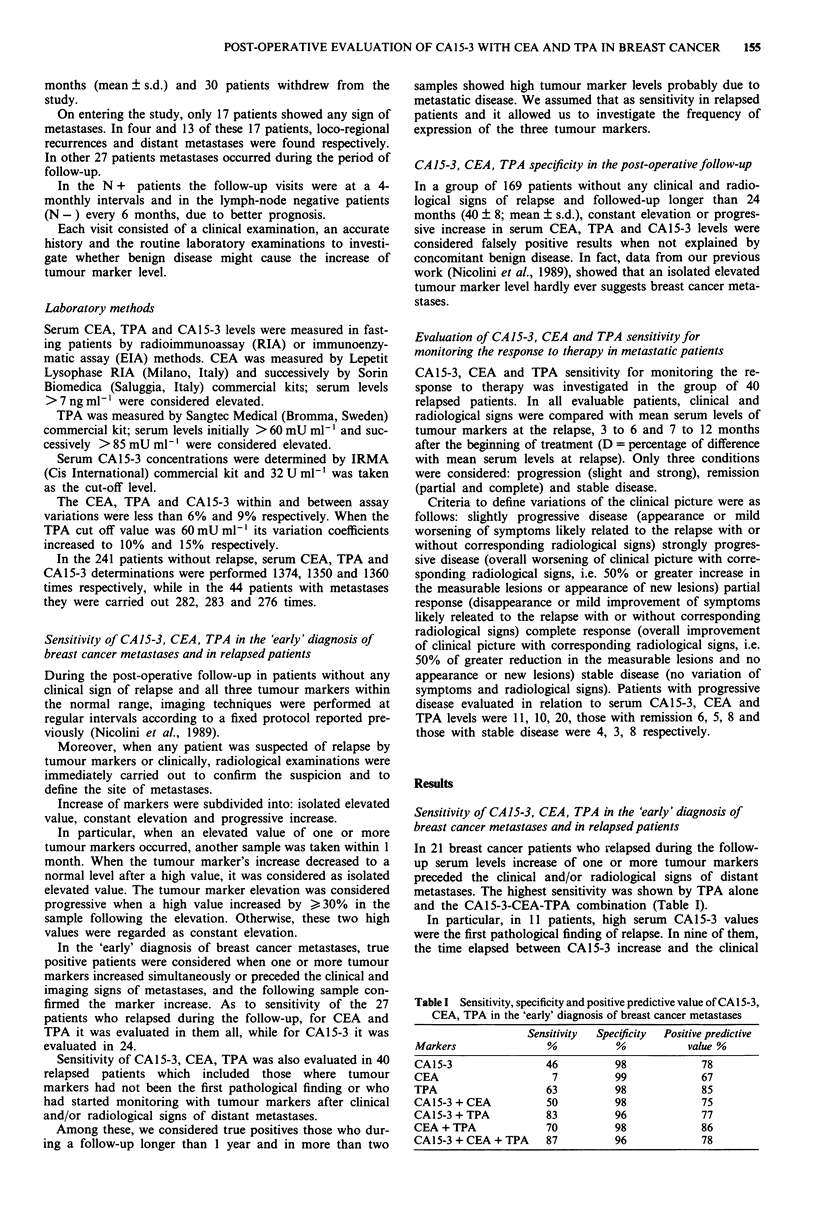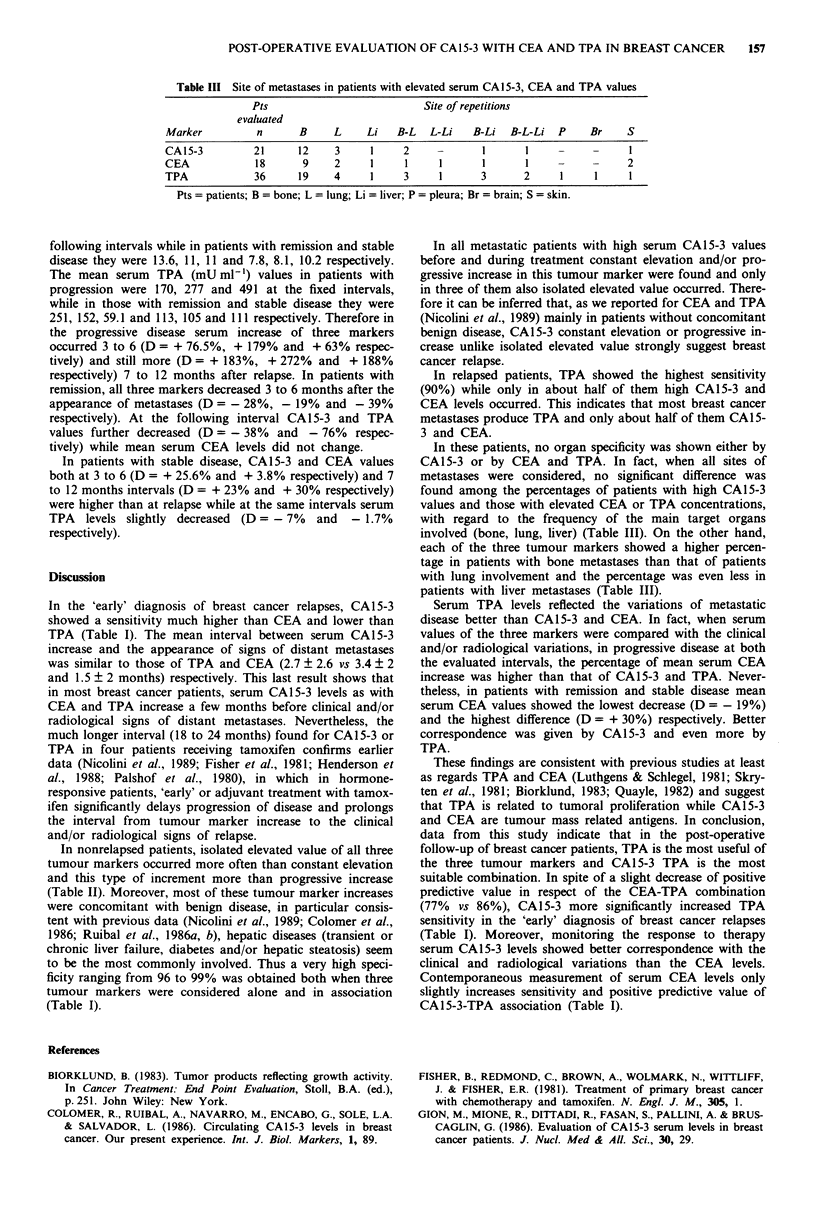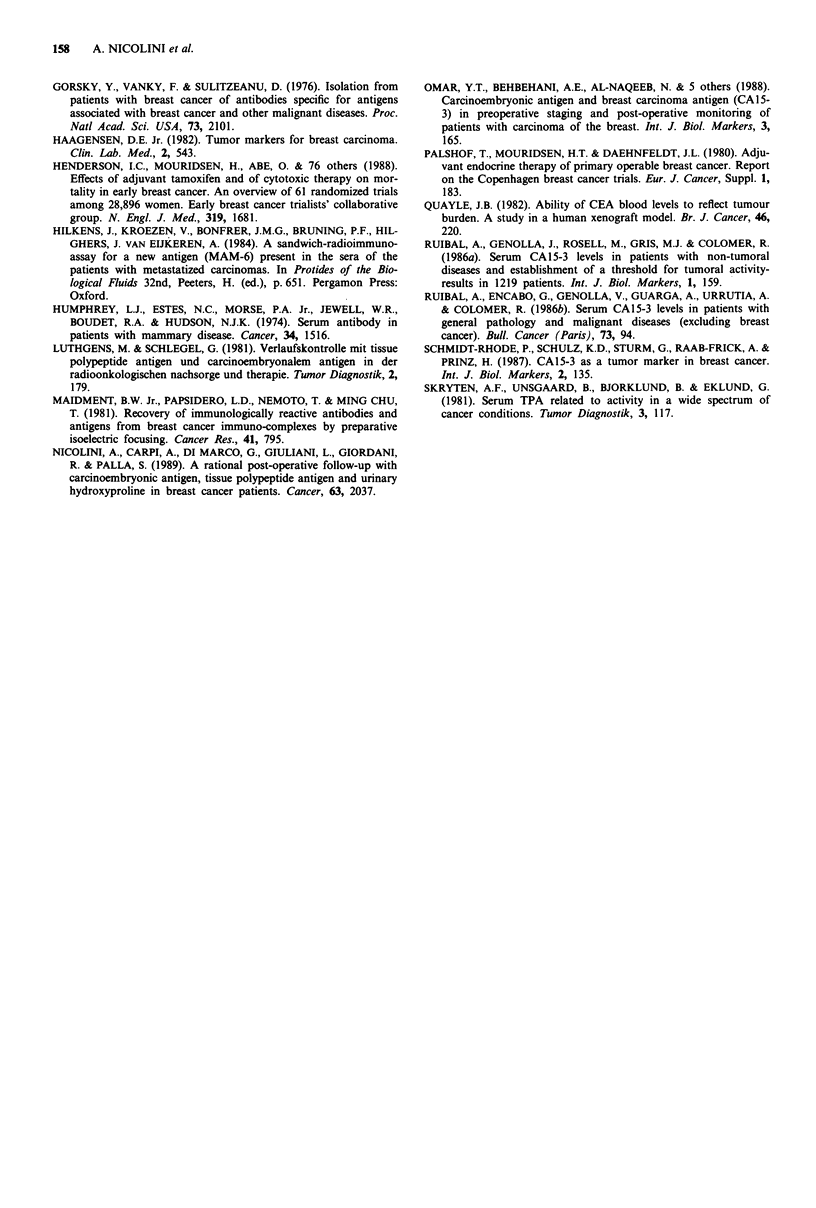Abstract
The usefulness of post-operatively serial serum CA15-3 determination with CEA and TPA was evaluated in a group of 285 breast cancer patients. In particular, the CA15-3 sensitivity to 'early' diagnosis and monitoring of the response to treatment of breast cancer relapses, was compared with those of the two other markers in order to define the most suitable association. Moreover, in a group of 169 non relapsed patients with a prolonged follow-up (40 +/- 8 months; mean +/- s.d.) CA15-3 specificity was investigated. During post-operative follow-up in 27 (10%) patients, distant metastases occurred. In most of them, elevated values of one or more tumour markers were the first pathological sign and CA15-3, CEA and TPA sensitivity to 'early' diagnosis of metastases were 46%, 7% and 63% respectively. When each tumour marker was considered in combination, CA15-3-CEA-TPA association showed a higher sensitivity (87%) than both CA15-3-TPA (83%) and the CEA-TPA (70%). Serum CA15-3 increase preceded the certain sign of metastases 2.7 +/- 2.6 months (mean +/- s.d.). Shortly before appearance and during treatment of distant metastases, constant elevation and/or progressive increase in serum CA15-3 values occurred in all evaluated patients except three in whom isolated elevated values were found as well. In 24 (14%) of 169 non relapsed patients with prolonged follow-up (40 +/- 8 months; mean +/- s.d.) high serum CA15-3 values occurred. In 16 of these 24 patients, an isolated elevated value was found, while four (2.3%) or the eight remaining ones with constant elevation and/or progressive increase were falsely suspected of metastases. In this group of non relapsed patients, chronic liver failure, diabetes and/or hepatic steatosis were the reasons more commonly responsible for the CA15-3 increase. In metastatic patients, no organ-specificity was shown either by CA15-3 or by CEA and TPA. In these patients serum TPA values showed the highest sensitivity and paralleled clinical and/or instrumental signs better than the CA15-3 and even more than CEA values. These data indicate that in the post-operative follow-up of breast cancer patients, TPA is the most useful tumour marker and TPA-CA15-3 the most suitable association. Contemporaneous measurement of serum CEA levels only slightly increases sensitivity and positive predictive value of TPA-CA15-3 combination.
Full text
PDF




Selected References
These references are in PubMed. This may not be the complete list of references from this article.
- Colomer R., Ruibal A., Navarro M., Encabo G., Sole L. A., Salvador L. Circulating CA 15.3 levels in breast cancer. Our present experience. Int J Biol Markers. 1986 May-Aug;1(2):89–92. [PubMed] [Google Scholar]
- Fisher B., Redmond C., Brown A., Wolmark N., Wittliff J., Fisher E. R., Plotkin D., Bowman D., Sachs S., Wolter J. Treatment of primary breast cancer with chemotherapy and tamoxifen. N Engl J Med. 1981 Jul 2;305(1):1–6. doi: 10.1056/NEJM198107023050101. [DOI] [PubMed] [Google Scholar]
- Gorsky Y., Vanky F., Sulitzeanu D. Isolation from patients with breast cancer of antibodies specific for antigens associated with breast cancer and other malignant diseases. Proc Natl Acad Sci U S A. 1976 Jun;73(6):2101–2105. doi: 10.1073/pnas.73.6.2101. [DOI] [PMC free article] [PubMed] [Google Scholar]
- Haagensen D. E., Jr Tumor markers for breast carcinoma. Clin Lab Med. 1982 Sep;2(3):543–565. [PubMed] [Google Scholar]
- Humphrey L. J., Estes N. C., Morse P. A., Jr, Jewell W. R., Boudet R. A., Hudson M. J. Serum antibody in patients with mammary disease. Cancer. 1974 Oct;34(4 Suppl):suppl–suppl:1520. [PubMed] [Google Scholar]
- Maidment B. W., Jr, Papsidero L. D., Nemoto T., Chu T. M. Recovery of immunologically reactive antibodies and antigens from breast cancer immune complexes by preparative isoelectric focusing. Cancer Res. 1981 Mar;41(3):795–800. [PubMed] [Google Scholar]
- Nicolini A., Carpi A., Di Marco G., Giuliani L., Giordani R., Palla S. A rational postoperative follow-up with carcinoembryonic antigen, tissue polypeptide antigen, and urinary hydroxyproline in breast cancer patients. Cancer. 1989 May 15;63(10):2037–2046. doi: 10.1002/1097-0142(19890515)63:10<2037::aid-cncr2820631028>3.0.co;2-1. [DOI] [PubMed] [Google Scholar]
- Omar Y. T., Behbehani A. E., al-Naqeeb N., Motawy M. M., Folldi M. O., Awwad A. H., Nasralla M. Y., Szymendera J. J. Carcinoembryonic antigen and breast carcinoma antigen (CA 15.3) in preoperative staging and postoperative monitoring of patients with carcinoma of the breast. Int J Biol Markers. 1988 Jul-Sep;3(3):165–171. doi: 10.1177/172460088800300304. [DOI] [PubMed] [Google Scholar]
- Palshof T., Mouridsen H. T., Daehnfeldt J. L. Adjuvant endocrine therapy of primary operable breast cancer. Report on the Copenhagen breast cancer trials. Eur J Cancer. 1980;Suppl 1:183–187. [PubMed] [Google Scholar]
- Quayle J. B. Ability of CEA blood levels to reflect tumour burden: a study in a human xenograft model. Br J Cancer. 1982 Aug;46(2):220–227. doi: 10.1038/bjc.1982.187. [DOI] [PMC free article] [PubMed] [Google Scholar]
- Ruibal A., Encabo G., Genollá J., Guarga A., Urrutia A., Colomer R. Serum CA 15.3 levels in patients with general pathology and malignant diseases (excluding breast cancer). Bull Cancer. 1986;73(1):94–95. [PubMed] [Google Scholar]
- Ruibal A., Genollá J., Rosell M., Gris J. M., Colomer R. Serum CA 15.3 levels in patients with non-tumoral diseases, and establishment of a threshold for tumoral activity. Results in 1219 patients. Int J Biol Markers. 1986 Sep-Dec;1(3):159–160. doi: 10.1177/172460088600100308. [DOI] [PubMed] [Google Scholar]
- Schmidt-Rhode P., Schulz K. D., Sturm G., Raab-Frick A., Prinz H. CA 15.3 as a tumour marker in breast cancer. Int J Biol Markers. 1987 Sep-Dec;2(3):135–142. doi: 10.1177/172460088700200301. [DOI] [PubMed] [Google Scholar]


